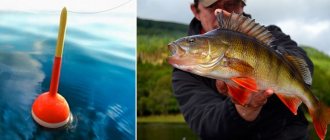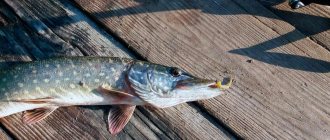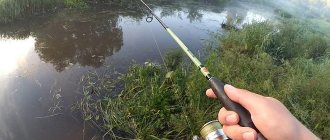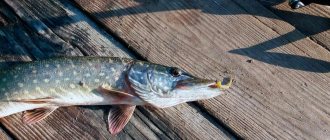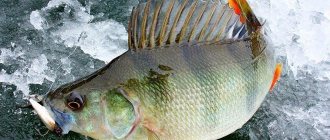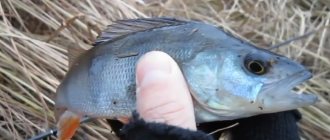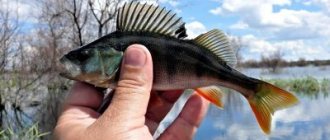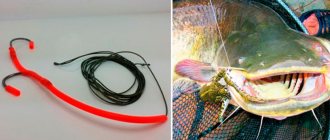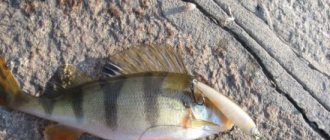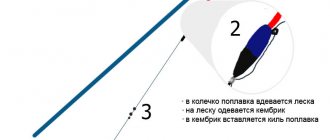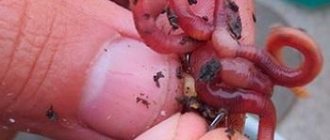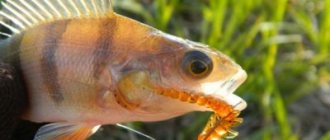There are many ways to equip a spinning rod for different fishing methods: with a lead, Carolina, Texas, jig, microjig, spinners, spinners, wobblers, etc. But there is a time when the bites of large fish are extremely sluggish, then you can switch to searching for small perch, along the coastal drop-off or along the edge of the grass, using the following equipment.
Read the article about choosing a spinning rod and fishing rod for perch.
Garland of silicone baits
Try the following equipment, which you will need:
- Line diameter 0.35
- Fluorocarbon 0.22
- Small twisters of different colors
- Single hooks
- Sinkers of 15-20 grams (if there is no current, use a smaller weight)
Let's start manufacturing.
First of all, we cut the fluorocarbon into 10 cm pieces, in the amount of 3-5 pieces. We retreat 15-20 cm from the end of the main line and tie the first leash. See the diagram for how to tie two different fishing lines. Tying with a “Grinner” type knot is shown in the photo below:
We repeat the procedure several times, retreating from the knots by 15-20 cm. We tie single hooks to the leashes, you can use a “clinch” knot. A little secret: in order to prevent the twisters from flying off at the first bite, choose those hook models that have notches on the shank. Some fishermen additionally lubricate the forend with super glue for reliability.
We equip all hooks with silicone; the method is no different from equipping an offset hook. A sinker of the selected weight is mounted at the end of the main line. For versatility, use a swivel that allows you to change the weight of the weight depending on the fishing location. A figure eight loop is knitted at the second end of the main line.
For clarity, watch a detailed video in which the angler shows all the stages of making his gear. Questions that may have appeared during reading should disappear.
The spinning equipment discussed in the article is described in order to give the reader new ideas and make it clear that experimentation and practice are a fisherman’s best friend.
Carolina rig and split shot
Date: February 25, 2015 | 478
Now I want to talk about two very interesting equipment used when fishing with soft baits. They are not very common, they are not used very often, although, under certain conditions, their efficiency is much higher than that of a conventional jig rig. We will talk about the Carolina rig and the split shot. Outwardly, these installations are similar, but there are also significant differences. Let's look at them in more detail, understand the components of installations, their advantages and areas of use.
The Carolina rig is quite similar to the Texas rig. In any case, the set of components is approximately the same. So, the Carolina equipment includes:
— Sliding weight in the shape of a bullet;
- A small plastic bead;
— Swivel;
— Leash made of fishing line or fluorocarbon;
— Offset hook with silicone bait.
We put a bullet weight on the main fishing line or spinning cord, then a bead and tie a swivel. The bead is needed so that the weight does not damage the knot. The sliding weight makes this rig somewhat similar to bottom fishing with a roller, all impulses from the bait and bites are transmitted directly to the tip of the spinning rod and the sinker does not resist this and does not scare off the fish with its weight.
Next, a leash is attached. The strength of the leash is chosen to be slightly less than the strength of the main cord. The length of the leash can vary from 15-30cm to 50cm or more. And we tie an offset hook to the end of the leash, onto which we already attach the desired silicone baits. You can tie the hook in different ways, either with a regular knot or with a loop, so that the hook has even greater freedom of movement, freely sliding the ring along the loop.
Such equipment, of course, will not be as snag-free as the Texas one. There, the bullet weight quite successfully protects the hook from snags. Here, the freedom of action of the bait on a leash can lead to it getting caught and caught on snags. The rig goes through the grass quite well.
The main advantage of the Carolina rig is not the passage of snags, but the style of presentation of the bait. On the one hand, we can use a very heavy load, which means we can fish at any depth and current. At the same time, we can use different baits, including very small ones, and the presence of a large load nearby will not scare away the fish. The Carolina rig can be classified as a family of spaced rigs, where the load and bait are located at some distance from each other. Sometimes this is important and gives better results than other equipment.
In addition, Carolina rigs with silicone baits, which have positive buoyancy and tend to float, work very effectively. There are many of these that can be found in the variety of modern edibles. During pauses, when the load falls to the bottom, the bait floats up above the bottom, and if there is a current, it plays nicely, even during pauses. This is a good technique.
The Carolina rig is used with equal success on overgrown shallows, hunting for pike in the grass, and at very significant depths, on the edge. If you are hunting for pike purposefully, then the issue of leash is acute. It is not advisable to use metal leashes, they greatly spoil the performance of the bait... So, either use an insert made of the thinnest elastic leader material, or use relatively thick 100% fluorocarbon, or take risks by fishing without a leash.
A split shot is a very similar, but slightly different rig. This is also a spaced installation, the weight and the bait are somewhat spaced from each other. The split shot belongs rather to the microjig, ultralight class. In the Carolina rig, both light and very heavy weights can be used, but here the weight is very small and light, rarely more than 5g.
A hook with a small bait is tied on the fishing line of the spinning rod, or directly on the cord, and a lead pellet is clamped higher, 20-50 cm. The hook can be used either offset or simple single.
This rig also allows you to spread the bait and weight apart. A split shot is especially relevant when the fish is capricious and does not want to bite on classic microjig rigs. So, often passive perch or rudd are caught much more successfully with a spaced split shot than with a classic one.
In addition, a beautiful effect is achieved with floating silicone, when the shot goes along the bottom and the bait floats above. Of course, the play of silicone on a leash is much more realistic than in hard contact with a weight.
In the West, the split shot is more popular than here. They use specially shaped hooks and special pellets with a protrusion. I think this is all overkill. Few people here fish with split-shots on any systematic basis. Use this equipment as an addition when necessary. And in these rare episodes, the usual elements of editing, simple small hooks, pellets that floaters use, will do just fine.
So, keep in mind such rigs as Carolina and split shot and you can introduce their use into your spinning routine.
Share with your friends:
Categories: Installations · Tags: Installation, Offset hook
Split shot is a good option
The following method has proven to be excellent when fishing with a microjig; it is called a split shot, reminiscent of a Carolina rig. The differences between them are that in a split shot the sinker is round in shape and rigidly fixed. In the Carolinas, bullet-shaped weights are more commonly used.
Let's get started. We cut the leash to the required length, there are no special recommendations. Its length can be 50-100 cm, the optimal option is selected by trial and error. An offset machine is tied to the segment using any knot, usually a clinch. A loop is made at the other end, threaded into the ear of the eared weight and secured.
Please note that a carabiner is attached to the second free eye of the load, connecting the tackle to the main braided fishing line. This makes it easy to replace it in case of small bites. The video below clearly shows the process of knitting a split.
Deaf Splitshot
If the jig doesn’t bite, Splitshot can help out. But this is the equipment that we will modify to further improve its performance.
In the form in which we use a splitshot, the rig consists of a “Cheburashka” weight attached to the main fishing line, to which a fluorocarbon leash 40-120 cm long is attached.
At the end of the leash there is a hook with bait - a twister, slug, vibrotail or something else.
Splitshot scheme:
The splitshot catches fish well, often catching jigs, but it has significant disadvantages:
- very mediocre sensitivity to bites;
- the cargo actively collects “garbage” from the bottom and often gets stuck in the rocks.
A small modification not only eliminates these problems, but also makes installation a little easier.
This is interesting: Spinning fishing with a retractable leash - technique and bait used
Retractable leash or Moscow equipment
If fishing conditions are such that you need to persuade sluggish fish to bite by holding the playing bait in place for a long time or throw it far away where it is impossible to increase the weight of the jig load, Moscow equipment helps out.
Installation methods and baits used are described in sufficient detail in the corresponding article. In short, a drop-shaped weight or, better yet, a drop-shot stick is attached to the end of the retract line. Above it, a swivel is tied with a long leash made of monofilament (for example, fluorocarbon), to which the bait is in turn attached. Any bait is used: from twisters and vibrotails, to creatures, crayfish and even small floating wobblers with shallow depth.
The wiring of the rig can be very different, depending on the situation and the fish that needs to be caught. So, for perch, uniform wiring with slight swaying works well, and for pike perch, sharper jerks, vaguely reminiscent of twitching, work well.
Despite the fairly high catchability, the diverting leash has a number of significant disadvantages.
- Firstly, it is low information content. It appears due to the fact that there is no direct contact with the bait and the sensations that we get in our hands during retrieving most often come from the load passing over the unevenness of the bottom. Thus, cautious bites are hidden and the fish makes itself known only after some time, when it has caught itself. And this doesn't happen often.
- Secondly, the Moscow equipment has extremely low mobility and mobility. If there is an installation option that allows you to quickly put the equipment into use and, if necessary, just as quickly replace it with something else, then the problem with casting remains. Fishing rarely happens in ideal conditions where you can swing well. And to cast the Moscow rig, the swing space must be clean, without interference in the form of bushes, tall grass, etc.
Some other equipment for fishing with edible rubber and silicone.
Tips for choosing vibrotails, twisters and other edible baits.The rating of the best inertia-free wires will tell you why some have smooth wiring, while others have jerky and elusive wiring.
Split shot wiring technique
Split shot is a universal equipment that allows for various wiring methods. Depending on the conditions on the reservoir, the mood of the predator and other factors, the angler has the right to choose the most optimal presentation of the bait, which will encourage the predator to grab.
The main options for wiring a split shot are as follows:
- Dragging along the bottom. It is used for passive fish located in the lower horizons.
- Step-by-step retrieving with long pauses at the bottom and slight movements of the rod tip. Suitable when the predator closes its mouth without reacting to classic montages.
- Wave-like in the water column. Used if the perch feeds in the middle layers and behaves relatively lively.
- The classic jig “step” is a basic supply of equipment used in areas with sparse aquatic vegetation. Suitable for fish of different activity levels.
Experienced spinning players use animation with various jerking techniques. This allows you to diversify the game of bait, which increases the number of bites from a sluggish predator or when fishing in compacted reservoirs, where local underwater inhabitants have well studied the “habits” of fishermen.
In any case, the variability of fishing directly depends on the skill and experience of the fisherman. Beginners need to experiment by adding various elements to basic feeds. This way, it will be faster to find the key to an intractable predator, pushing it to a confident bite.
spinning-club.ru
